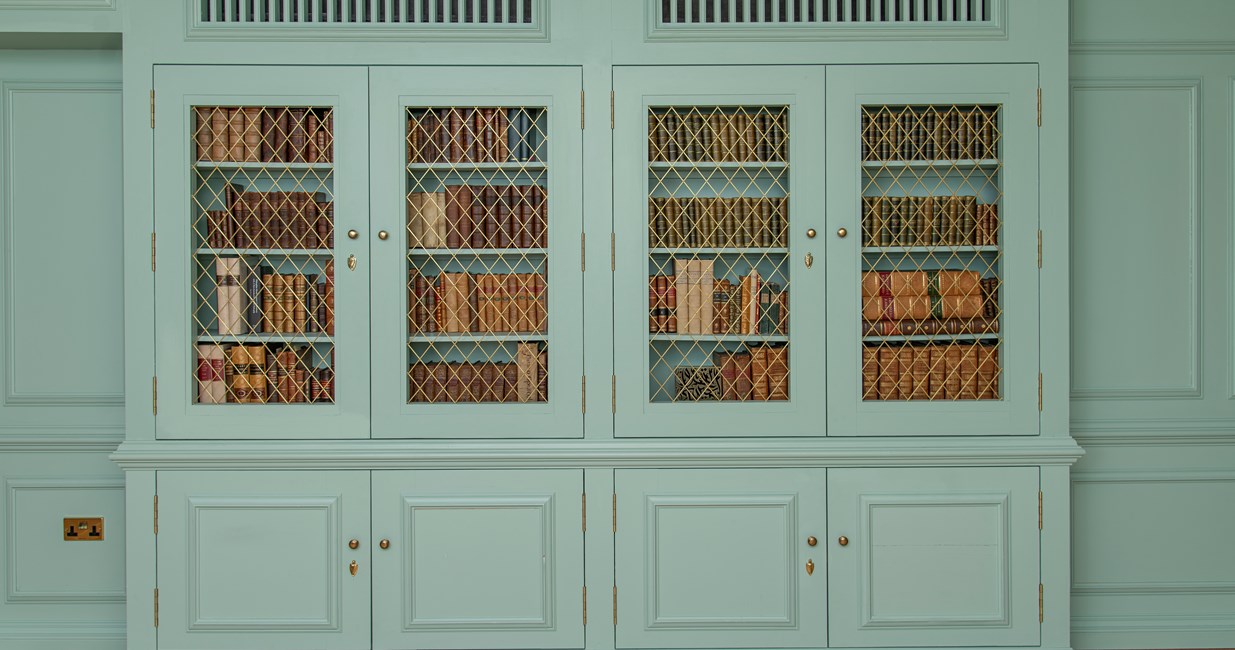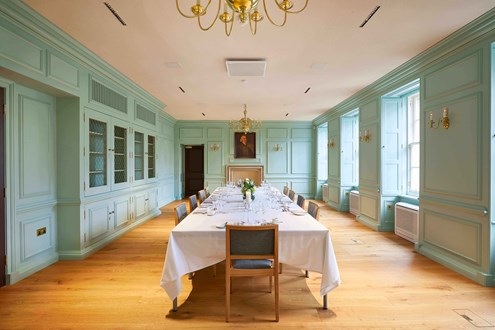INTRODUCTION TO THE SMITH LIBRARY RESTORATION
library catalogue
A Library Catalogue has been created to accompany the Smith Restoration Library. This details each book, the selection criteria and context surrounding Adam Smith's history and his ownership of each book.
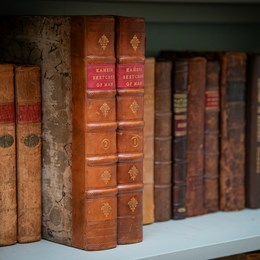
A History
The primary goal of the most recent renovation of Panmure House, completed in 2018, was always to make this remarkable building a centre for debate and the free flow of ideas. Central to this idea has been Adam Smith and his masterworks and how Adam Smith himself developed the ideas he committed to paper.
As was the technology of the time, books were the centre of Smith's learning throughout his life, from early life in Kirkcaldy, through to University in Glasgow at 14 and throughout his career as a Professor and Lecturer, Private Tutor and Travel Companion to the Duke of Buccleuch, writer and finally Comptroller of Customs for Scotland. When designing the redevelopment of the rooms within Panmure House, provision for bookcases was made in the Reading Room. A plan was then put in place to fill these shelves with a wealth of knowledge befitting the setting and the plan to restore copies of Adam Smith's original collection was born.
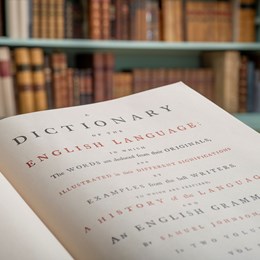
Adam Smith and the Printed Page
Born in 1723 in Kirkcaldy, Scotland, Adam Smith stands as a key figure in the Scottish Enlightenment, acclaimed for his seminal work, The Wealth of Nations.
Smith lived in Kirkcaldy with his mother until 1776, when he moved to rooms in London to oversee the publication of The Wealth of Nations, and returned to live in Edinburgh here at Panmure House in 1778 until his death in 1790.
Adam Smith’s father, also Adam, passed away several months before young Adam was born. Elder Adam was educated and took the bar exam in Edinburgh before becoming the of Customs in Kirkcaldy, acutely aware his income was dictated by the levels of trade. According to Ian Simpson Ross’ The Life of Adam Smith he left a library of roughly eighty books covering subjects such as Religion, Belle Lettres and classics, Law, Astronomy, and others including what some may have described as profane and, in many languages, including Latin and French. This alongside the dedication of his family and those entrusted with his education set young Adam on a course which would change the world for the better.
Smith's extensive original library at Panmure House housed over 3000 volumes and mirrored his insatiable intellectual curiosity and proficiency in various languages. Functioning as the crucible of his groundbreaking ideas, the collection provides insight into the diverse influences that shaped Smith's intellectual landscape. This restoration explores Adam Smith's library, its contents, and its profound impact on his enduring legacy.
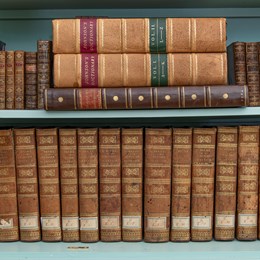
Where is Adam Smith's Library today?
Adam Smith's book collection, an inherited literary legacy, unveils a captivating narrative. Originally passed on to David Douglas, Lord Reston (1769-1819), the library was divided among Lord Reston's daughters. David Anne Douglas (1819-79), who wed Rev. James Bannerman (1807-1868), bequeathed her share to their son, Rev. David Douglas Bannerman.
Remarkably, the Bannerman family's collection, nearly entirely preserved, was donated to New College Edinburgh's library in 1884 and is now part of Edinburgh University Library, containing around 900 titles—the largest consolidated portion. Conversely, Cecilia Margaret Douglas (1813-98), married to Rev. William Bruce Cunningham (1806-78), inherited books with a complex fate. Some volumes were sold in 1878, dispersing among private collectors and institutions such as Glasgow University, Kirkcaldy Museum (7 titles), Edinburgh University, Goldsmith's Library (59 titles), and Johns Hopkins University Library (60 titles). The remaining Cunningham volumes were donated to Queen's University Belfast in 1918 by her son, Professor Robert Oliver Cunningham, with additional books reaching Glasgow University in the 1960s. Despite exhaustive efforts to locate these books, approximately 411 titles remain unaccounted for, as per Mizuta.
Some titles sporadically appear in the book market, necessitating continuous catalogue updates. Alongside Adam Smith's 1781 catalogue, valuable resources include Bonar's 1894 and 1932 catalogues, Tadao Yanaihara's 1951 Tokyo catalogue, the completed 2000 Mizuta catalogue, and recent Tokyo and Glasgow catalogues. Together, these resources illuminate the intriguing journey of Adam Smith's cherished library.
'I am a beau in nothing but my books.'
This famous refrain attributed to Smith came about while in discussion with printer
William Smellie whilst showing Smellie his library in Panmure House.
Book Selection for the Library
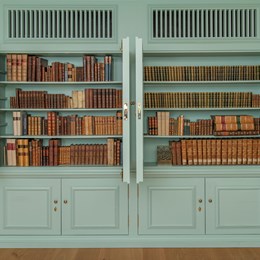
Adam Smith was a significant collector of books throughout his life. Several of his biographers cite the reported comment that he was a ‘beau in nothing but my books’ which he is supposed, according to John Raes account the Life of Adam Smith, to have made to the printer William Smellie who was admiring his library during a visit to Smith’s home, here at Panmure House, on the day before the start of the French Revolution.
The catalogue of Smith’s library from 1781, which is duplicated in Yanihara’s A full and detailed catalogue of books which belonged to Adam Smith, provides a detailed description of the library in Smith’s Edinburgh home written by or overseen by Adam Smith himself. It is from here we can attribute the position of these books in Panmure House.
The criteria for selection and purchase of the books which follow in this catalogue are as follows:
- Edition, year of publication and publisher of the book to be the same as recorded in A Catalogue of the Library of Adam Smith’ by James Bonar and the subsequent ‘
- Books and Authors that are directly quoted in Smith’s work.
- Books which are historically important.
- Books which are culturally important, especially those referencing Edinburgh, other luminaries of the Scottish Enlightenment, Adam Smith’s job role while living at Panmure House and those which record Scotland’s history.
- Cost of purchase for a book. Over time, some of the books which would have been very available during the time of Smith have become rarer and more difficult to source. If they are available and in good condition, the cost of purchase may be prohibitive in which case a later alternative will be sourced.
It should be noted that books do not have to satisfy all criteria to be selected for purchase. For example, while every effort is made to purchase a correct edition and printer published book, due to price, availability, condition, and location this is not always possible. In these cases, later or other versions have been sourced so that the title is present in the library, and this is noted in the entries for these books.
Unless otherwise stated in the entries, these books are the texts specific to those that Adam Smith once owned in edition and publisher and filled the bookshelves of Panmure House. As not owned by Smith, the bindings, marginalia, and condition will of course differ.
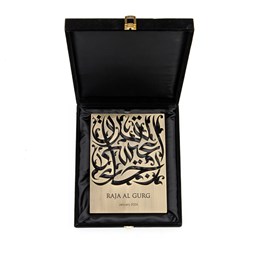
Special thanks to our sponsor
We would like to thank Dr Raja Easa Al Gurg for her kind donation with which the initial section of the Adam Smith Restoration Library has been acquired.
A leading businessperson in her own right, Dr Al Gurg has carved a unique niche for herself in the region due to her support and encouragement of Arab women entrepreneurs. She is the Founder of the Dubai Businesswomen Council and Member of the Board of Directors of Dubai Chambers.
Dr Al Gurg is the Deputy Chairperson of the National Bank of Fujairah and on the advisory board of Coutts Bank, the wealth division of the Royal Bank of Scotland Group. She is a member of the Board of Directors for Dubai Academic Health Corporation and Vice Chairperson of University of Dubai.
In 2022, she has been appointed as Honorary Pro-Chancellor at Heriot Watt University, a premier global education provider with a rich heritage stretching back to 1821, bringing together scholars who are leaders in ideas and solutions delivering innovation, educational excellence, and ground-breaking research. She is also on the Board of Directors of the Emirates Schools Establishment, an independent entity which oversees the implementation of policies, strategies, and standards related to the education sector.
Besides providing valuable counsel to various business groups and international trade alliances, Dr Raja Al Gurg spends considerable time in several philanthropic, social and charitable activities, notably with the Easa Saleh Al Gurg Charity Foundation and as Chairperson of the Board of Directors of Al Jalila Foundation, a UAE organisation with global aspirations dedicated to making lasting and significant contributions in healthcare to transform lives.
Support The ongoing work of Panmure House
If you would like to be involved in supporting the projects at Panmure House please contact us and a member of the team will be in touch too discuss your questions.


